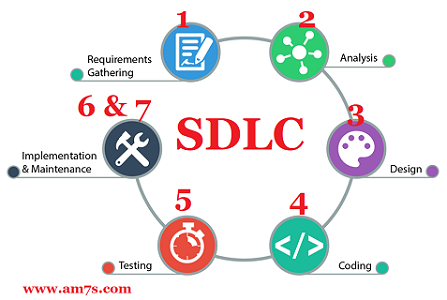SDLC – programming securely
The Software Development Lifecycle(SDLC) is a systematic process for building software that ensures its quality and correctness. It is a framework that defines tasks performed at each step in the software development process.
A formally defined method for software development in the form of the SDLC achieves a number of benefits:
- A common vocabulary for each step
- Defined communication channels between development teams and stakeholders
- Clear roles and responsibilities among developers, designers, business analysts, and project managers
- Clearly-defined inputs and outputs from one step to the next
- A deterministic “definition of done” that can be used to confirm whether a step is truly complete

- Identify the current problems. “What don’t we want?” This stage of SDLC means getting input from all stakeholders, including customers, salespeople, industry experts, and programmers. Learn the strengths and weaknesses of the current system with improvement as the goal.
- Plan. “What do we want?” In this stage of SDLC, the team defines the requirements of the new software and determines the cost and resources required. It also details the risks involved and provides sub-plans for softening those risks. In this stage, a Software Requirement Specification document is created.
Resource allocation (both human and materials)
Capacity planning
Project scheduling
Cost estimation
Provisioning
- Design. “How will we get what we want?” This phase of SDLC starts by turning the software specifications into a design plan called the Design Specification. All stakeholders then review this plan and offer feedback and suggestions. It’s crucial to have a plan for collecting and incorporating stakeholder input into this document. Failure at this stage will almost certainly result in cost overruns at best and total collapse of the project at worst.
- Build. “Let’s create what we want.” This SDLC stage develops the software by generating all the actual code. If the previous steps have been followed with attention to detail, this is actually the least complicated step.
- Test. “Did we get what we want?” In this stage, we test for defects and deficiencies. We fix those issues until the product meets the original specifications.
Code quality
Unit testing (functional tests)
Integration testing
Performance testing
Security testing
- Deploy. “Let’s start using what we got.” Often, this part of the SDLC process happens in a limited way at first. Depending on feedback from end users, more adjustments can be made.
- Maintain. “Let’s get this closer to what we want.” The plan almost never turns out perfect when it meets reality. Further, as conditions in the real world change, we need to update and advance the software to match.
Exampled of SDLC
- Waterfall Model. This SDLC model is the oldest and most straightforward. With this methodology, we finish one phase and then start the next. Each phase has its own mini-plan and each phase “waterfalls” into the next. The biggest drawback of this model is that small details left incomplete can hold up the entire process.
- Agile Model. The Agile SDLC model separates the product into cycles and delivers a working product very quickly. This methodology produces a succession of releases. Testing of each release feeds back info that’s incorporated into the next version.

- Iterative Model. This SDLC model emphasizes repetition. Developers create a version very quickly and for relatively little cost, then test and improve it through rapid and successive versions. One big disadvantage here is that it can eat up resources fast if left unchecked.

- V-Shaped Model. An extension of the waterfall model, this SDLC methodology tests at each stage of development. As with waterfall, this process can run into roadblocks.

- Big Bang Model. This high-risk SDLC model throws most of its resources at development and works best for small projects. It lacks the thorough requirements definition stage of the other methods.

- Spiral Model. The most flexible of the SDLC models, the spiral model is similar to the iterative model in its emphasis on repetition. The spiral model goes through the planning, design, build and test phases over and over, with gradual improvements at each pass.
